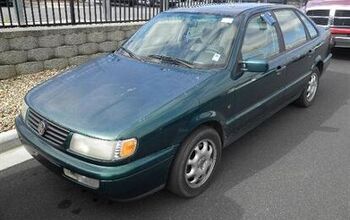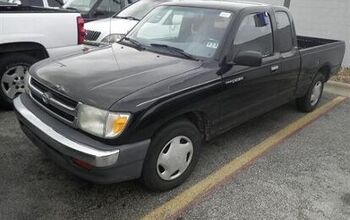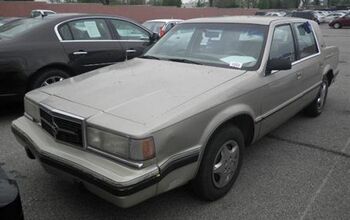Monday Mileage Champion: Lawdy! Lawdy!
Lawdy! Lawdy! Guess who’s 40!
Well, it happened. After a weekend where my daughter scores the game winning basket and the trade-ins numbered 6432, I hit the golden age of middle age.
As for the 1983 Jeep Grand Wagoneer in the picture, would you believe 403,224 miles? That little factoid was just the very tip of a long data drilldown.
Not to mention a few unusual future contests between the automakers in what will now be called the Trade-In Quality Index… or TIQI for short!
The grandest of Wagoneers was followed by a Ford truck and six consecutive Toyota products. All in all, the quintet of Ford trucks, Chevy trucks, Hondas, Toyotas, and Panther vehicles took 23 of the top 30 mileage spots. If you were extra kind and added Dodge trucks and Jeep SUV’s into the mix, that number swelled to 27 out of 30 top spots.
But that wasn’t the big surprise. Not even close. For that you have to start with Europe. All of Europe.
The European nameplates encompassed 13 different brands, over 60 nameplates, and exactly 1018 trade-ins this past week. Only 48 of those vehicles had over 180,000 miles, and only 20 of the 1018 reached the ripe old automotive age of 18. I should mention now that the outift furnishing me with all this data wears a nice big smiley face of dealerships across the USA with only a few spots where rust is an issue.
So I’ve made the longevity measurement a bit further out so that maybe, perhaps, we could look at the impact OBD-II standards will have on the longevity of vehicles by next year.
Anyhow, the European marques lost to Toyota and Honda on both measurements. Not to mention a long list of others. What I didn’t expect was that all 13 European brands would lose to the Honda Accord alone and nearly lose to the Toyota Camry.
Vehicles with over 180k at trade-in
Accord 58 / 204 vehicles
Camry 45 / 171 vehicles
EU 48 / 1018 (VW, Audi, BMW, Volvo, SAAB, Land Rover, Jaguar, Mercedes, Mini, Maserati had 1, Porsche, Smart, Lotus)
Now keep in mind, a team of twelve people are tracking an awful lot of criteria at this point. The data is a bit overwhelming. So here is a Cliff Notes version of week one.
Those with the healthiest ratio of vehicles traded-in at over 180k, versus those traded in at less than 120k were…
Toyota 1.52
Honda 1.61
Lexus 1.62
Chevy Truck 2.07
and the big surprise
Pontiac 2.45
This means that for every Pontiac traded in at over 180k, there were approximately two and a half that were traded in at less than 120k. Pontiac barely beat out Acura and Ford trucks by the slimmest of margins. However we are incorporating a long list of other criteria (see the spreadsheet) along with time of ownership into this study. (for those that qualify)
By that measurement alone the winners for week one are…
1) Buick
2) Acura
3) Toyota
4) Honda
5) Cadillac
Keep in mind this is only week one and I am willing to give in to the fact that state registrations will provide a far better record of longevity than this 300k vehicle study. Still, the folks coming in to trade these vehicles typically use them as commuters instead of garage queens and barn molderizers. The Buicks and Cadillacs from 1995 on down may not be driven a lot, and especially by us enthusiasts. But they are well regarded by the grey haired Shoney’s crowd here in North Georgia and elsewhere. So it’s only fitting we give them a little bit of their due.
Now to the fun part. Out of all the laggards that are higher volume brands, it appears that Volkswagen, Hyundai and Kia are going to suffer the most. Volkswagen only attained 5 vehicles with over 180k out of 221. Who beat them?
This model. The Pontiac Grand Prix. A model that is not synonymous with any level of quality. Good or bad. The Grand Prix realized 11 vehicles out of 50 with over 180k miles. So for the remainder of this year we are going to track how the Grand Prix does relative to the #2 sized manufacturer in the world.
Then we have Kia and Hyundai. Personaly, I am just dead dog tired of having folks tell me how wonderful these brands are compared with so-called crappy domestics. So I’m going to let these South Korean juggernauts do battle with GM’s defunct import fighter. You know. The one that doesn’t have the word Old in it. The one to the left. No, not SAAB. The other one!
South Korea vs. Saturn
8 / 203 vs. 11 / 95
There is an awful lot of good data we have at the moment, and as we get more of it, we’ll delve in deeper to mehanical issues and the weaknesses and strengths of specific models. For now enjoy the spreadsheet below. All the best!
More by Steven Lang
Latest Car Reviews
Read moreLatest Product Reviews
Read moreRecent Comments
- W Conrad I'm not afraid of them, but they aren't needed for everyone or everywhere. Long haul and highway driving sure, but in the city, nope.
- Jalop1991 In a manner similar to PHEV being the correct answer, I declare RPVs to be the correct answer here.We're doing it with certain aircraft; why not with cars on the ground, using hardware and tools like Telsa's "FSD" or GM's "SuperCruise" as the base?Take the local Uber driver out of the car, and put him in a professional centralized environment from where he drives me around. The system and the individual car can have awareness as well as gates, but he's responsible for the driving.Put the tech into my car, and let me buy it as needed. I need someone else to drive me home; hit the button and voila, I've hired a driver for the moment. I don't want to drive 11 hours to my vacation spot; hire the remote pilot for that. When I get there, I have my car and he's still at his normal location, piloting cars for other people.The system would allow for driver rest period, like what's required for truckers, so I might end up with multiple people driving me to the coast. I don't care. And they don't have to be physically with me, therefore they can be way cheaper.Charge taxi-type per-mile rates. For long drives, offer per-trip rates. Offer subscriptions, including miles/hours. Whatever.(And for grins, dress the remote pilots all as Johnnie.)Start this out with big rigs. Take the trucker away from the long haul driving, and let him be there for emergencies and the short haul parts of the trip.And in a manner similar to PHEVs being discredited, I fully expect to be razzed for this brilliant idea (not unlike how Alan Kay wasn't recognized until many many years later for his Dynabook vision).
- B-BodyBuick84 Not afraid of AV's as I highly doubt they will ever be %100 viable for our roads. Stop-and-go downtown city or rush hour highway traffic? I can see that, but otherwise there's simply too many variables. Bad weather conditions, faded road lines or markings, reflective surfaces with glare, etc. There's also the issue of cultural norms. About a decade ago there was actually an online test called 'The Morality Machine' one could do online where you were in control of an AV and choose what action to take when a crash was inevitable. I think something like 2.5 million people across the world participated? For example, do you hit and most likely kill the elderly couple strolling across the crosswalk or crash the vehicle into a cement barrier and almost certainly cause the death of the vehicle occupants? What if it's a parent and child? In N. America 98% of people choose to hit the elderly couple and save themselves while in Asia, the exact opposite happened where 98% choose to hit the parent and child. Why? Cultural differences. Asia puts a lot of emphasis on respecting their elderly while N. America has a culture of 'save/ protect the children'. Are these AV's going to respect that culture? Is a VW Jetta or Buick Envision AV going to have different programming depending on whether it's sold in Canada or Taiwan? how's that going to effect legislation and legal battles when a crash inevitibly does happen? These are the true barriers to mass AV adoption, and in the 10 years since that test came out, there has been zero answers or progress on this matter. So no, I'm not afraid of AV's simply because with the exception of a few specific situations, most avenues are going to prove to be a dead-end for automakers.
- Mike Bradley Autonomous cars were developed in Silicon Valley. For new products there, the standard business plan is to put a barely-functioning product on the market right away and wait for the early-adopter customers to find the flaws. That's exactly what's happened. Detroit's plan is pretty much the opposite, but Detroit isn't developing this product. That's why dealers, for instance, haven't been trained in the cars.
- Dartman https://apnews.com/article/artificial-intelligence-fighter-jets-air-force-6a1100c96a73ca9b7f41cbd6a2753fdaAutonomous/Ai is here now. The question is implementation and acceptance.




































Comments
Join the conversation
how were are able to tell the millage of the Jeep? The odometer rolls at 100k. (At least it does on my 1986 GW).
The Saturns have plastic body panels that don't accumulate door dings, surface rust or paint fade. I wonder how much a car in decent cosmetic shape benefits in longevity by being more likely to be repaired because, gosh, it's still a good looking car. In the case of Saturn, it can't be because of the state-of-the-art drivetrain.